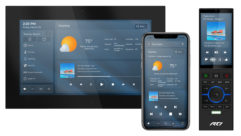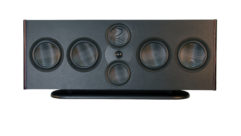
CEDIA Sounds
Oct 1, 2006 12:00 PM,
By Dan Daley
Stealthy speakers, soundproofing, and HDMI at Denver show.
September’s CEDIA Expo in Denver was muscular. Cab drivers were amazed and satisfied, as were an estimated 28,000 attendees (an 8 percent increase over last year in Indianapolis), who made this the largest CEDIA Expo ever — a reflection on the huge growth of installed media as a sector.

There’s a lot more audio and systems to install, too. More manufacturers use CEDIA Expo as an introductory venue, which again underscores the growing importance of the installed media sector. (Read more about the video sector at CEDIA on page 16.) Lots of speakers fell into this category, such as the new Genelec home theater monitors. The AIW25 active in-wall loudspeaker, the AIC25 active in-ceiling loudspeaker, and the AOW312 active on-wall loudspeaker are installer-friendly, says Karen Richardson, Genelec’s national sales mangager.
“The bottom line is that installers, both commercial and residential, need to provide seamless high-quality sound systems that fit an esthetic look,” she says. “That’s the thinking behind this line of speakers, and I think that’s a critical component throughout the CEDIA landscape: Focus on the needs of the installer and help them do their jobs better.”
JBL’s speaker offerings, including the debut of its JBL Cinema Sound CS6100 and CS480, two 5.1-channel speaker packages that combine the new CSB5 wall-mountable satellite loudspeaker, were more specifically targeted at integrators this year.
“At CEDIA 2006, JBL is targeting the specialized requirements of the custom-installation market to a greater extent than ever before,” says Paul Bente, president of JBL. “We are expanding our product lines to offer a wider variety of application-driven solutions across a broader range of categories, from high-value compact loudspeaker packages to state-of-the-art systems that deliver the ultimate cinema experience in the home.”
SHAKING ALL OVER
One significant trend that emerged at the show was the disappearing speaker. This phenomenon had been showing up lately at more commercially oriented venues such as InfoComm, in which transducers are attached to any reasonably resonant surface and voilá, le speaker. But what had been a gimmick used by department stores to turn windows into loudspeakers has migrated to the residential install side.
Induction Dynamics’ SolidDrive transducer comes in a set (the X and D versions) that together cover the spectrum from 150Hz to 18kHz. Stealth Acoustics’ flatpanel speakers live up to their claim of invisibility. The technology is based on a 3/16in. paper-and-foam faceplate that is actually the active surface of the speaker. Installers, or ambitious homeowners, will like the fact that the speakers come packaged with their own installation templates. The aluminum-mounting frame is attached to the structural framing with drywall screws secured through the mounting frame into the studs. The edge of the face panel is tapered in a manner similar to drywall board. The seam between the face panel and the drywall board is taped and feathered in with joint compound in the same manner as a drywall patch. Amina Technologies showed (or not, depending upon how you look at it) its AIWI SoundUnseen plaster in-wall concealed sound source speakers.
The debate over the sonics of in-wall versus freestanding speakers remains an endless one. However, they stand apart from the stealth solution offered by one particular manufacturer. A new line of speakers comes with Pier One-esque tchochki coverings like faux lamps and chime clocks. It makes one long for the days when audio components were proudly displayed.
SEEN AND HEARD
Plenty of speakers liked to be heard and seen, though. YG Acoustics was a first-time exhibitor and its four-way Anat Reference Studio speakers were breathtaking, which they had to be at $60,000 a pair. On the other end of the spectrum, Sennheiser was displaying its RS130 wireless headsets aimed at the residential market.
“It’s often a marriage-saver when it comes to whether television is on or off in the bedroom,” jokes Al Zang of Sennheiser. “Seriously, installed media is seeing more requests for quality sound, as well as silent cinema.”
If the speakers were getting less visible, another show trend was to also make them less audible. At least, not heard when you didn’t want to hear them. Soundproofing has become a big business for systems installers and contractors alike, and some of the products and systems shown at CEDIA Expo will help get them on the same page.
Quiet Solution’s QuietRock has been around a while and appeals to home theater installers and builders alike since it has the same characteristics as regular drywall. Kinetics Noise Control, Cascade Audio, and Wallmate also showed sound-control products and systems aimed at the burgeoning home theater market.
“People have realized that noise control is just as much an issue as anything else connected with home theater,” says Larry Holden, Kinetics’ VP and point man on home theaters. “The range of solutions installers now have really reflects that.”
SYSTEMS
CEDIA calls its front-line troops “electronic systems technicians,” and the emphasis is on systems these days. Exceptional Innovation’s LifeWare-based Next-Gen Home, with partners including Klipsch, Panasonic, Microsoft, and Intel, was set up across the street from the convention center entrance and drew crowds all weekend long. The interior systems install, including the high-tech kitchen, cost about $80,000 — probably more than the 2,000-square-foot structure itself — but it was the architectural equivalent of a GM concept car, a glimpse of things to come.
Less opulent, but equally predictive of future home automation trends was the Zensys Z-Wave array, which takes home automation, including audio control, down market with partners including Intermatic and Leviton. A lot of these products are plug-and-play. Installers, especially those who have migrated from the ailing recording studio business, take note: Keep an eye on how consumer-accessible technologies affect the professional domain.
AMX integrated VoIP capability into its Modero touchpanel line of controllers. “With our new Moderos, a separate intercom system is no longer needed,” says Robert Noble, AMX’s vice president of product management and marketing. “The same touchpanels that control and automate homes can now also be used to improve communication between families.”
Crestron introduced its new Isys i/O TPMC-8X WiFi touchpanel, featuring an embedded Windows XP operating system that provides secure onboard PC functionality, including 802.11g wireless capabilities and 1.5GB-plus of memory. “We’re offering more plug-and-play solutions, such as Adagio and WiFi touchpanels, that make installation and integration much faster and easier,” says Crestron’s Jeff Singer.
More traditional twisted-pair telephone control was shown by Elan Home Systems. Its new COM2 communications controller provides security and control data over two phone lines and independent access to four Elan Door Stations.
Wireless systems control took another forward step at the show with the introduction of a wireless HDMI device from Tzero Technologies and Analog Devices. HDMI is trying to become a major buzz, and the ability to run audio, video, and control data on a single cable is a significant advance for home and commercial media installation. It is the only interface in consumer electronics that can carry both uncompressed high-definition video and uncompressed multichannel audio in all HD formats, including 720p and 1080i. Taking it wireless adds even more potential, especially in existing structures.
Speakers are sexy, but racks work just as hard. Middle Atlantic’s three new thermostatically controlled Quiet Cool racks — the Component Cooler, the Cabinet Cooler, and the Closet Cooler — are designed to remove heat that degrades AV component performance.
“Digital technology is susceptible to difficult-to-diagnose, quality-impeding intermittent failures,” says Middle Atlantic’s Mark Tracy. “The new Quiet Cool family enables contractors to provide thermal solutions in an array of applications.”
CEDIA Expo will be back in Denver for the next three years. It seems like a good fit, and with that much exposure to audio gear, the Mile-High City might have the best sound in the country.
Dan Daleyis a veteran freelance journalist and author, specializing in media and entertainment technology and business sectors. He lives in New York, Miami, and Nashville, Tenn. and can be reached at[email protected].










